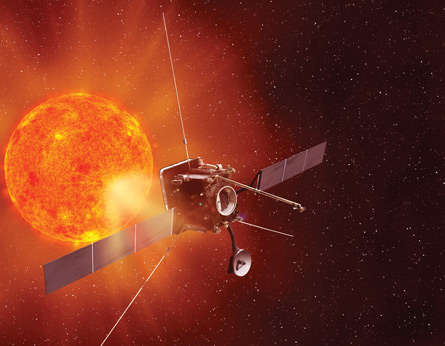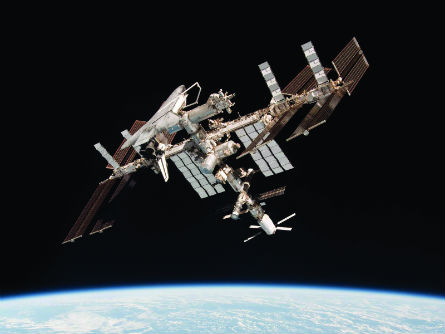For the European Space Agency, 2012 has been a year that opened with great success with the maiden flight of its all-new light launcher Vega, and has moved into a phase of preparation for an ambitious programme of science and exploration, along with the exploitation of space assets. Four key areas of activity are in focus: access to space, navigation, Earth observation and deep space exploration.
When he declared 2011 to be ESA's "year of launchers", agency director general Jean-Jacques Dordain hoped to have three rockets flying from the European spaceport in Kourou, French Guiana during the year: the heavy-lifter Ariane 5 and two newcomers, the Russian middle-weight Soyuz and ESA's own Vega. But while Soyuz entered service as planned in October 2011, Vega's first flight was pushed back to February of this year. However, any disappointment was washed away by the flight. A resounding triumph, especially as two-thirds of maiden launches end in failure, the flight successfully orbited its scientific payloads and validated a range of innovative technologies including new avionics, one of the largest one-piece carbonfibre structures in production and a capability of de-orbiting the final booster stage after payload delivery, to minimise the launcher's contribution to the problem of orbiting debris - which experts regard as a near-crisis issue.
 |
|---|
Astrium EADS Astrium will launch the Solar Orbiter mission in 2017 |
LAUNCHERS
Vega - ideally suited to place 1.5t payloads into 700km polar orbits, or about half the capacity of Soyuz when launched from Kourou - is now being readied for a series of five flights in the so-called VERTA programme (Vega Research and Technology Accompaniment), likely to orbit observation or scientific payloads and ready the launcher for commercial customers. Next flight is expected in February or March 2013, possibly carrying the latest in ESA's Proba series of in-orbit technology validation satellites, which includes the Proba-2 spacecraft that captured stunning images of May's solar eclipse and June's transit of Venus.
Longer-term Vega developments include a likely replacement of the fourth stage, currently the tried-and-tested RD-869 restartable engine built in Ukraine and also used as the third stage on the Dnepr launch vehicle and its predecessor, the SS-18 (SATAN) intercontinental ballistic missile.
Soyuz, meanwhile, will continue to orbit Europe's Galileo navigation satellites (see below), with a two-satellite payload scheduled for launch on 28 September.
But one of the - literally - biggest developments at ESA this year involves Ariane 5, with the award to EADS's Astrium division of a €112 million ($142 million) contract to develop the rocket's long-discussed Midlife Extension, a set of improvements that will add a fifth to its 10t to geostationary orbit payload capability without increasing the launch cost. Or, put another way, the launch cost per kilo should be cut by 20%.
 |
|---|
ESA An Ariane 5 launches from Kourou |
The ME will be able to orbit two 5t-plus payloads per launch, a significant financial proposition for ESA's launch operator, Arianespace, as most Ariane flights carry commercial rather than government satellites. The main upgrade will be a new restartable upper stage and an extension of the nose fairing to accommodate larger and heavier payloads.
GALILEO
By the time an operational constellation is flying in 2014, Europe's satellite navigation system will be some seven years behind its originally envisaged timetable. But the result should be worth the wait, and to the great credit of ESA and the Galileo system's champion on the European Commission, Antonio Tajani, the programme is moving forward with impressive speed. Convinced Europe needed an independent capability in navigation - and a civilian-controlled system to balance the USA's military-controlled GPS - Tajani last year pressed industrial partners to find the cost savings needed to give ESA the go-ahead to organise a fast-track launch manifest, which the Commissioner was able to announce at the 2011 Paris air show.
SOYUZ FLIGHT
A year on, the two operational spacecraft launched last October by ESA's first Kourou Soyuz flight have demonstrated in-orbit functionality and a raft of further units are in production. The launch plan aim is to orbit 18 satellites by the end of 2014 for a functional service, and 26 satellites by the end of 2015 for near-global coverage. The full constellation of 27 spacecraft and three orbiting spares should be deployed by 2019. And, from the second half of 2014, a requalified Ariane launcher, known as Ariane 5 ES Galileo, should be equipped with a four-satellite dispenser and be capable of delivering the spacecraft to orbital altitudes of 23,200km. The current ES launcher is used to launch ESA's Automated Transfer Vehicle to the International Space Station at about 380km.
 |
|---|
ESA An International Space Station supply ship, the ATV, seen here at bottom, is the biggest spacecraft in service |
The Automated Transfer Vehicle remains one of ESA's most visible successes. Following retirement of NASA's Space Shuttle fleet, this robotic supply ship to the International Space Station is the biggest spacecraft in service, capable of delivering 6.6t of cargo. The third ATV, launched earlier this year, will remain attached to the ISS until the end of August when, like its two predecessors, it will undock and de-orbit, burning up in the atmosphere. A fourth ATV - named Albert Einstein - is being readied for launch in 2013, and a fifth will end the programme.
ATV is a one-way vehicle, but ESA is also working on re-entry capabilities, with some expectation a re-entry capable capsule could be spaceworthy by 2015 followed by further development to provide transportation for four astronauts by 2020. Indeed, one Vega payload for 2013 could be the Intermediate eXperimental Vehicle (IXV), a 2t lifting body testbed being developed to simulate return from a low-Earth orbit mission - for example from the ISS - with hypersonic and supersonic flight phases before a parachute-assisted Pacific sea landing.
One precursor to the IXV test has fallen victim to a change of policy by the Russian defence ministry. ESA expected to make a suborbital flight of a smaller ballistic capsule called Expert - European Experimental Re-entry Testbed - on a Volna sea-launched rocket in spring 2012, but the launch vehicle is no longer available for a civil mission, leaving ESA to seek another delivery option and is hopeful that the mission will fly in 2013. Expert will test aero-thermodynamic phenomena typical of atmospheric re-entry vehicles and validate computational tools and windtunnel predictions by comparison with high-quality flight data.
EARTH OBSERVATION
One significant setback this year was the loss of the Envisat mission. In April, only weeks after marking its 10th anniversary in orbit, one of the most sophisticated Earth observation spacecraft suddenly stopped transmitting data. Observations from the ground and other spacecraft confirmed the satellite remained in a stable orbit, but all attempts to regain communications failed and the mission was formally closed in May. Despite the mission's official end, engineers continue to try to re-establish contact, but will have given up by the time the Farnborough air show opens.
The demise of Envisat leaves ESA - and thousands of scientists worldwide - with a gap in what has been a hugely valuable source of data on land, atmosphere, oceans and ice caps. Envisat also provided data on deforestation, ground displacements triggered by earthquakes and volcanic eruptions, and disasters such as floods and oil spills. ESA hoped Envisat would remain in service until replacements could be launched, so an anxious highlight of 2013 will be the first launch in the Global Monitoring for Environmental Security "Sentinel" programme in the fourth quarter.
ESA's Mars exploration ambitions looked in peril earlier this year when Washington budget cuts left partner NASA having to pull out of ExoMars, a two-legged mission to the red planet launching in 2016 and 2018. However, Russian space agency Roscosmos stepped in to provide the launches for an ESA-built orbiter and descent module demonstrator in 2016 and rover in 2018, along with some scientific payloads and, in 2018, much of the landing module. The two agencies expect to sign a formal agreement by year-end. ESA also moved forward this year with Sun studies, contracting EADS Astrium to build the Solar Orbiter spacecraft, which will provide images of the star's poles. The mission, run in collaboration with NASA, will launch in 2017.
SATURN MISSION
A highlight of ESA's science programme is the Cassini mission to Saturn, run in partnership with NASA and the Italian space agency, ASI. Cassini dropped the Huygens probe onto Saturn's moon Titan in 2005, the only spacecraft to land in the outer solar system. Stunning views of the Saturnian system should keep coming at least through 2017.
ESA has also set its sights on Jupiter's icy moons, with a mission to Europa, Ganymede and Callisto set for an Ariane 5 launch in 2022. The Jupiter Icy moons Explorer (JUICE) mission will arrive in 2030 to spend at least three years in orbit. The moons are all thought to host internal oceans, so the mission will study them as potential habitats for life, addressing two key themes of Cosmic Vision: what are the conditions for planet formation and the emergence of life, and how does the solar system work?
 |
|---|
ESA Saturn and Titan, as shot from the Cassini spacecraft |
Ultimately, all these plans depend on the terrestrial matter of money. At €4.02 billion, ESA's 2012 budget is on a par with the past couple of years and agreement in principle has been reached with ESA's member countries on plans such as its ISS operations until 2020 and the Ariane 5 upgrade. But Dordain is keenly aware that member governments face severe budget problems. So while he is confident ESA's members recognise value for money in the space programme, he is also pressing for cost savings. Thus while the November meeting of member state ministers will not offer Vega's fiery drama, that conclave of budget holders may be the big event of the year.
Source: Flight International






















